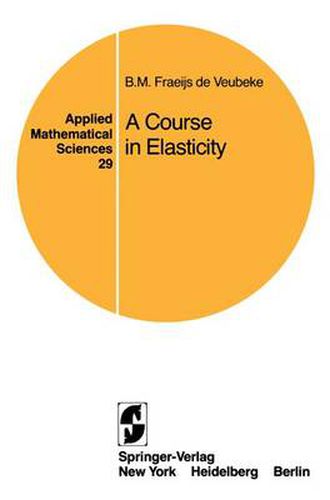Readings Newsletter
Become a Readings Member to make your shopping experience even easier.
Sign in or sign up for free!
You’re not far away from qualifying for FREE standard shipping within Australia
You’ve qualified for FREE standard shipping within Australia
The cart is loading…






This title is printed to order. This book may have been self-published. If so, we cannot guarantee the quality of the content. In the main most books will have gone through the editing process however some may not. We therefore suggest that you be aware of this before ordering this book. If in doubt check either the author or publisher’s details as we are unable to accept any returns unless they are faulty. Please contact us if you have any questions.
This book is based on lecture notes of the late Professor de Veubeke. The subject is presented at a level suitable for graduate students in engineering, physics, or mathematics. Some exposure to linear algebra, complex analysis, variational calculus, or basic continuum mechanics would be helpful. The first third of the book contains the fundamentals of the theory of elasticity. Kinematics of continuous media, the notions of stress and equilibrium, conservation of energy, ‘and the elastic constitutive law are each treated first in a nonlinear context, then specialized to the linear case. The remainder of the book is given to three classic applications of the theory, each supplemented by original re sults based on the use of complex variables. Each one of the three topics - Saint-Venant’s theory of prismatic beams, plane deformations, and the bending of plates - is first pre sented and analyzed in general, then rounded out with numerous specific and sometimes novel examples. The following notational conventions are generally in force, except where noted to the contrary: lower case boldface letters denote vectors or triples of Cartesian co ordinates, upper case boldface letters denote 3 x 3 matrices, repeated lower case Latin subscripts are summed over (1,2,3), and non-repeated lower case Latin subscripts are assumed to range over (1,2,3).
$9.00 standard shipping within Australia
FREE standard shipping within Australia for orders over $100.00
Express & International shipping calculated at checkout
This title is printed to order. This book may have been self-published. If so, we cannot guarantee the quality of the content. In the main most books will have gone through the editing process however some may not. We therefore suggest that you be aware of this before ordering this book. If in doubt check either the author or publisher’s details as we are unable to accept any returns unless they are faulty. Please contact us if you have any questions.
This book is based on lecture notes of the late Professor de Veubeke. The subject is presented at a level suitable for graduate students in engineering, physics, or mathematics. Some exposure to linear algebra, complex analysis, variational calculus, or basic continuum mechanics would be helpful. The first third of the book contains the fundamentals of the theory of elasticity. Kinematics of continuous media, the notions of stress and equilibrium, conservation of energy, ‘and the elastic constitutive law are each treated first in a nonlinear context, then specialized to the linear case. The remainder of the book is given to three classic applications of the theory, each supplemented by original re sults based on the use of complex variables. Each one of the three topics - Saint-Venant’s theory of prismatic beams, plane deformations, and the bending of plates - is first pre sented and analyzed in general, then rounded out with numerous specific and sometimes novel examples. The following notational conventions are generally in force, except where noted to the contrary: lower case boldface letters denote vectors or triples of Cartesian co ordinates, upper case boldface letters denote 3 x 3 matrices, repeated lower case Latin subscripts are summed over (1,2,3), and non-repeated lower case Latin subscripts are assumed to range over (1,2,3).